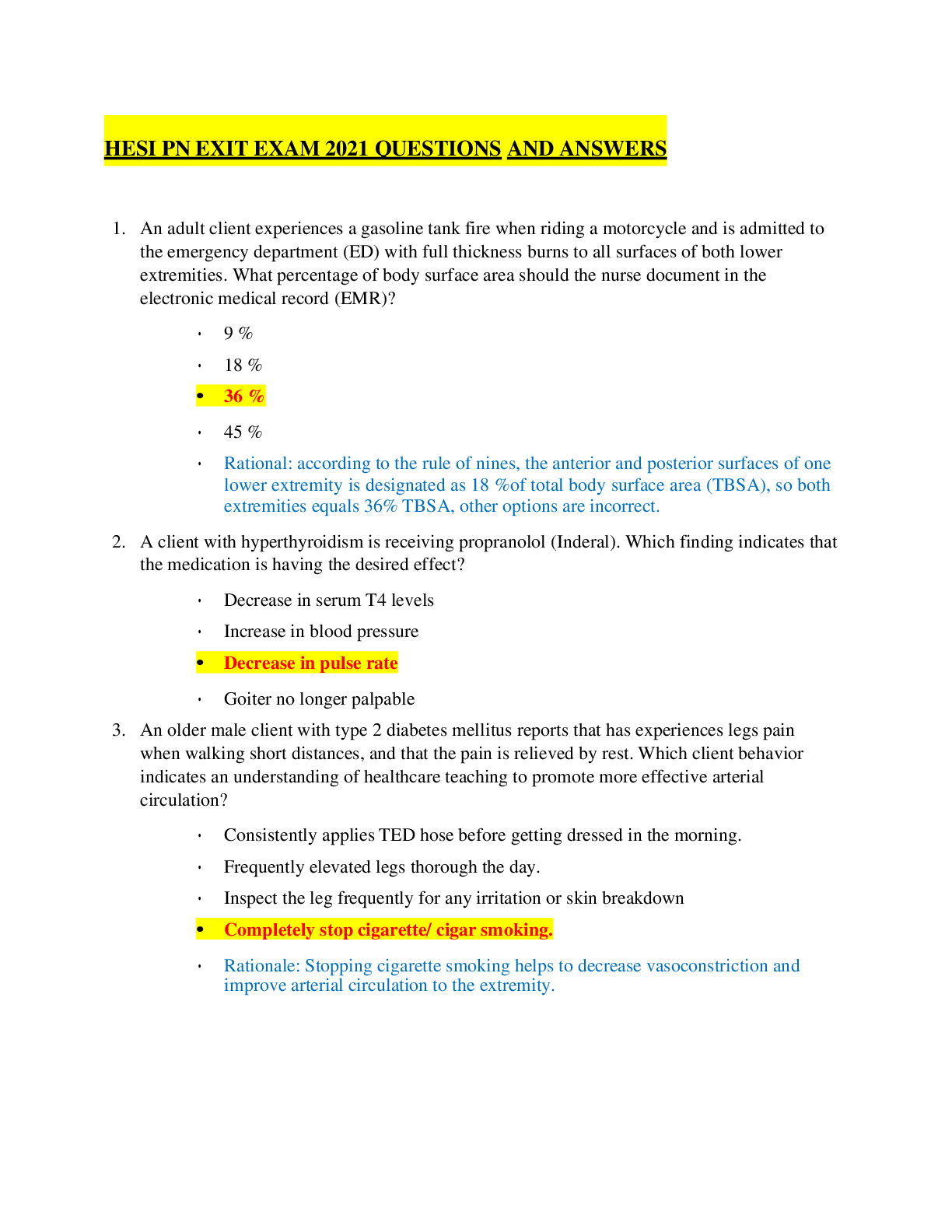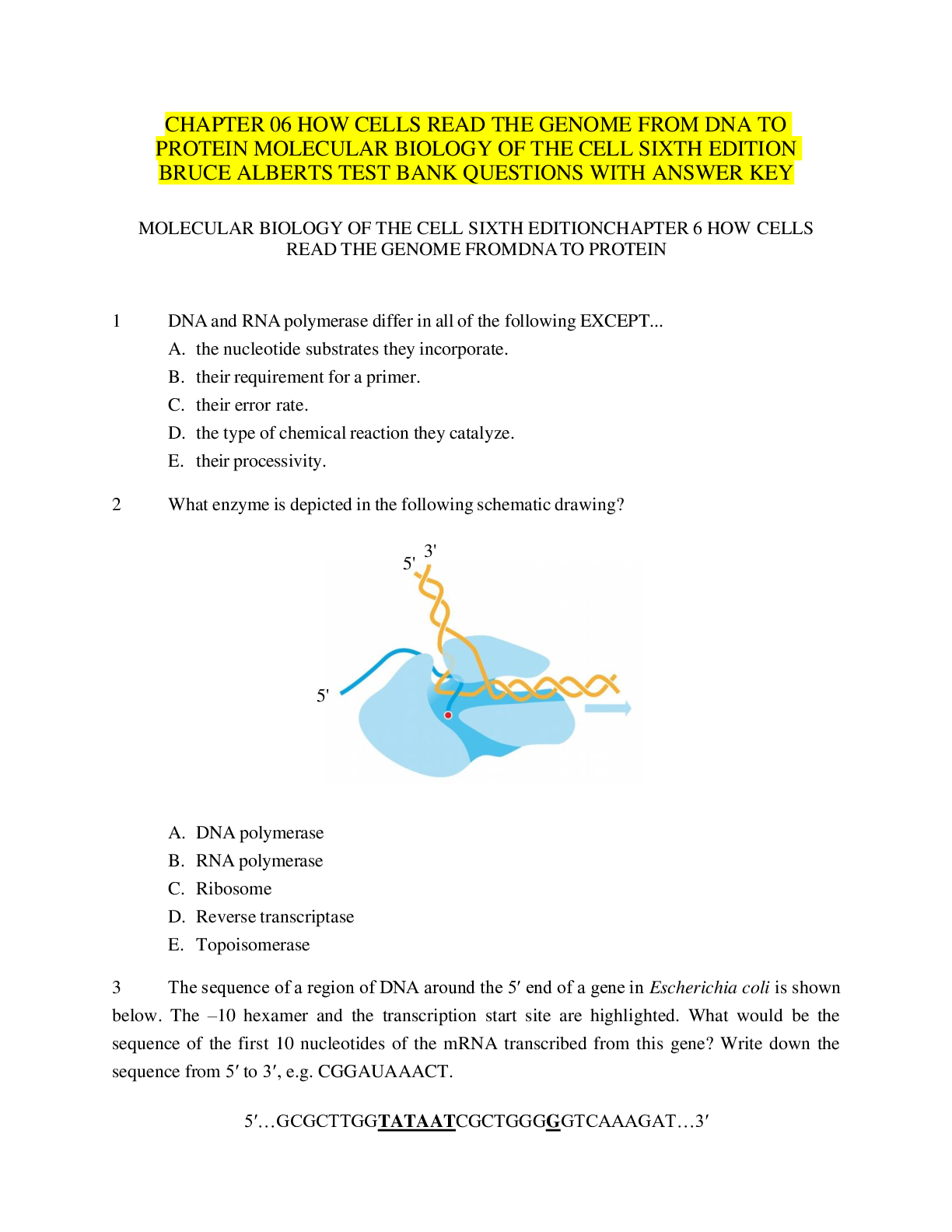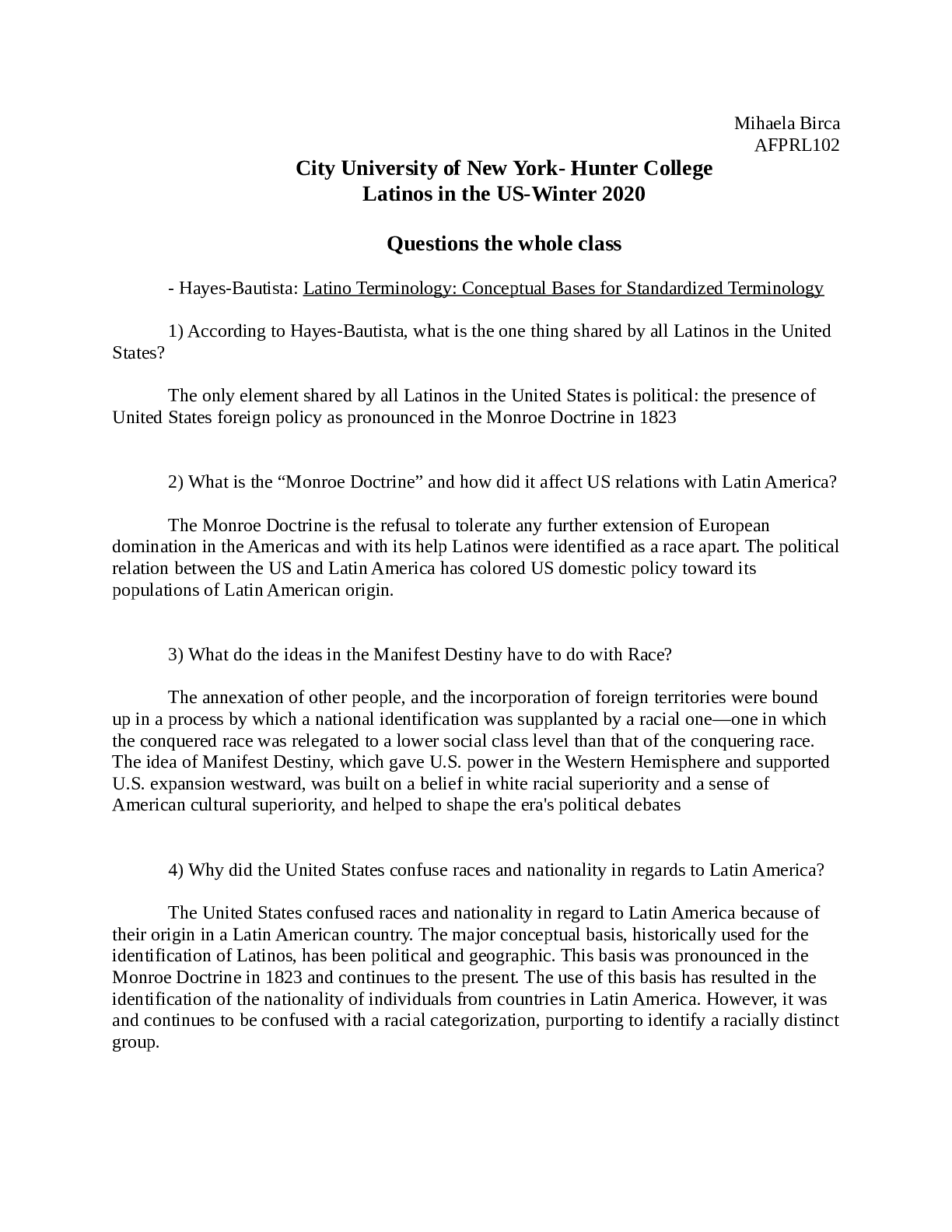History > QUESTIONS & ANSWERS > Latino Terminology Conceptual Bases for Standardized Terminology (All)
Latino Terminology Conceptual Bases for Standardized Terminology
Document Content and Description Below
Latino Terminology Conceptual Bases for Standardized Terminology - Hayes-Bautista: Latino Terminology: Conceptual Bases for Standardized Terminology 1) According to Hayes-Bautista, what is the on... e thing shared by all Latinos in the United States? The only element shared by all Latinos in the United States is political: the presence of United States foreign policy as pronounced in the Monroe Doctrine in 1823 2) What is the “Monroe Doctrine” and how did it affect US relations with Latin America? The Monroe Doctrine is the refusal to tolerate any further extension of European domination in the Americas and with its help Latinos were identified as a race apart. The political relation between the US and Latin America has colored US domestic policy toward its populations of Latin American origin. 3) What do the ideas in the Manifest Destiny have to do with Race? The annexation of other people, and the incorporation of foreign territories were bound up in a process by which a national identification was supplanted by a racial one—one in which the conquered race was relegated to a lower social class level than that of the conquering race. The idea of Manifest Destiny, which gave U.S. power in the Western Hemisphere and supported U.S. expansion westward, was built on a belief in white racial superiority and a sense of American cultural superiority, and helped to shape the era's political debates 4) Why did the United States confuse races and nationality in regards to Latin America? The United States confused races and nationality in regard to Latin America because of their origin in a Latin American country. The major conceptual basis, historically used for the identification of Latinos, has been political and geographic. This basis was pronounced in the Monroe Doctrine in 1823 and continues to the present. The use of this basis has resulted in the identification of the nationality of individuals from countries in Latin America. However, it was and continues to be confused with a racial categorization, purporting to identify a racially distinct group.5) What does the term “Hispanic” mean, and when did it start to be used? The term “Hispanic” was described as: "A person of Mexican, Puerto Rican, Cuban, Central or South America or other Spanish culture or origin, regardless of race." This is a new category that was created by executive fiat in the 1970s. 6) Why is “Latino” a better term than “Hispanic”? After an investigative reporting by the Los Angeles Times among the Mexican and nonMexican Latino population in Southern California it was determined that most Latinos rejected the term “Hispanic.” 7) What is the trait that most Latinos in US accept to have in common? The finding by the Times was that most respondents viewed "Latino" to be an adequate, appropriate, and acceptable self-description that expressed to their own satisfaction their desire to maintain a sense of national origin, while yet expressing links between them. As a result of this effort, the Los Angeles Times Style Guide states that: • Latino is the preferred umbrella term for all Spanish- surnamed groups in the United States. 8) Who is included by the term Latino and who is not included? Latino refers to geography, to the various countries in the Western Hemisphere . Specifically, to Latin America, to people from the Caribbean (Puerto Rico, Cuba, Dominican Republic), South America (Ecuador, Bolivia, Colombia, Peru, etc.) and Central America (Honduras, Costa Rica, etc.) Non-Latinos are Whites, African Americans, Asian. -Juan Gonzalez: The Role of the Church 1) How did the Crown and the Church consider the colonization and conversion of Natives? In Spain, both Crown and the Church saw colonizing and conversion as a unified effort. Priests accompanied each military expedition for the purpose of Christianizing the natives. 2) How do British and Spanish differ in their methods of subjugation? As the Conquest proceeded, priests performed baptisms by the thousands. Before the holy water could dry on their foreheads, the Indian women were routinely grabbed as concubines bySpanish soldiers and settlers. The priests even performed occasional marriages between Spaniards and Indians. The first English colonies, by contrast, began as family settlements. They maintained strict separation from Indian communities, sometimes even bolstered by segregation laws. In North America, Indians rarely served as laborers for settlers or ae household servants, and unmarried sexual unions between natives and whites were rare except for captives of war. 3) What were the views of the Puritans in regards to the Indians? New England Puritans segregated themselves from Indians. In 1643, sections of Harvard College were built with money raised by the New England Company among Anglicans back home. While donors were told the funds would be used for Indian education, some of the money ended up buying guns and ammunition for the colonists. So minor was Puritan concern for the Indians’ souls. They used people’s compassion towards the Indians to fulfill their needs with that money. 4) What was the role of the Catholic Church in the Spanish colonies? There were more natives in the Spanish colonies and the Catholic Church’s policies were more aggressive. Church leaders did more than merely recognize Indian humanity or accommodate mixed racial unities. In the Native Americans they imagined a simpler, less corrupt human being, one who could more easily be convinced to follow the word of Christ. 5) What was the legacy of Missionary orders to the Indians? The knowledge in agriculture, language, customs, or technology communicated to Indians by the missionaries remained part of Indian experience even after the last monk departed. -Haslip-Viera, Chapter 1, pp.3-23: 1) What were the socioeconomic background and national origin of “Latinos” in New York during the period 1810-1900? Merchants, businesspeople, artesian, skillful labors, students sent by their rich parents. 2) According to the census of 1890, how many Hispanics were living in New York, and where did most of them come from? 5994, Cuba, Mexico, South America, Spain3) What were the socioeconomic background and political affiliation of Latinos who came to New York after 1860? Tobacco manufacturing, liberals, socialists, white color workers, artisans, skilled workers, especially the tobacco merchants. Also included workers in factories, rooming houses, restaurants, pharmacies, barbershops, grocery stores. 4) Why did political exiles from the Caribbean come to New York? They included disaffected liberals, socialists and anarcho-syndicalists from Spain and Latin America. New York became the center for nationalist and revolutionary sentiment was reflected in the successful efforts to raise funds, publish newspapers. They were looking for money for papers and guns for the fight of their independence against Spain. 5) During Phase II of the migratory process, what region of Latin America sent the larger groups to New York? Of the Hispanic were Cuba, Porto Rico & Spain (40.7%) 6) How did the socio-economic background of Latinos change during Phase II? Blue colors, skillful labor, diversity of occupation. The instability of the economic structure. 7) In what neighborhood of New York did most Latinos live by late 1920s? Brooklyn, East Harlem, Lower East Side. 8) What group became predominant during the 1945-1970 period? Puerto Ricans 9) What changes took place in the Latino Populations in New York after 1965? A major increase of the Puerto Rican population of NY from 61k to 612K. - Gonzalez, “Pioneers…”, Chapter 5, pp.96-107 1) What factor makes Mexican-Americans to be unique among Latin American migrants to the US? Part of them were here already. They didn’t migrate from anywhere. Also, they contributed the most to the economy among Latin American migrants. 2) How did Mexican-Americans resist the annexation of their territories?They didn’t jump the frontier, the frontier jumped them. They fought back, they used laws and violence. 3) How did WWII impact the political situation of Mexican-Americans? US called a lot of immigrants to come to work and were promised citizenships. 4) What was the role of Cesar Chavez in the struggle for Mexican-Americans civil rights? His programs, organizations. - David Badillo, “Tejanos, Mexican Immigrants, and Mexican American Communities” 1) What economic process attracted Texas Mexicans into the Michigan economy? Large corporations involved in the growing and processing of beet sugar contracted with local growers for the employment of out-of-state seasonal labor, thereby introducing Mexicans into the Michigan economy. Development of agriculture. There were jobs as the economic conditions improved. 2) In what way were the betabeleros useful for the agricultural economy? Most of the betabeleros were experienced in the agricultural sector. They had been farmers, sharecroppers, or ranch hands prior to heading north. Area farmers relied on sugar beets as an important cash crop, but successful beet cultivation required periods of such intense drudgery that farmers had to find wage-laborers to expedite the work. Farmers and sugar companies actively recruited Mexicans and Chicanos, and the region drew many migrants. 3) How did the Mexican Revolution of 1910 affect the migration of Mexicans? Mexican Revolution accelerated the movement of Mexicans to the Southwest. It also spurred emigration from the interior states of the mesa central (central plateau), primarily Michoacán, Jalisco, and Guanajuato, to the Midwest. Railroads linked central Mexico with the Texas border cities of Laredo and El Paso and then connected with Kansas City, allowing for further direct passage. 4) What were the socio-economic differences between the Mexican migrants who came before and after the Mexican Revolution? More diverse occupational backgrounds, with some even skilled as tradesmen and industrial workers although most were agricultural workers in their home country.5) What were the socio-cultural conditions of Mexican barrios in Detroit? Poor housing. Railroads linked central Mexico with the Texas border cities of Laredo and El Paso and then connected with Kansas City, allowing for further direct passage. Track maintenance workers, in particular, obtained easy access to points farther north, and they sometimes established the first colonias, or barrios (urban settlements), in midwestern cities. 6) How did Detroit Mexicans view their immigration? The attachment of Detroit Mexicans to their homeland and culture necessitated periodic return to their homeland, causing immigrants to view immigration as a temporary phenomenon, preferring to retain their citizenship. 7) What was the impact of the Great Depression on Mexicans in Detroit? The collapse of auto manufacturing and the subsequent shutdowns in the early years of the Great Depression triggered mass layoffs in Michigan, causing thousands of Mexican nationals to lose their jobs. Their status made it hard to find new jobs. It deepened the rate of exploitation in labor sector. 8) How did the Defense boom and WWII stimulate a new Mexican and Tejanos migratory wave to Detroit? In 1942, facing a national labor shortage with the military draft in effect, the United States and Mexico negotiated contract labor agreements under the Bracero Program (which was repeatedly extended until 1964), allowing for the temporary or seasonal use of imported Mexican labor in various sectors of the economy. -Paloma Dallas, “The Big Apple’s Mexican Face” 1) Why did the number of Mexican immigrants to New York increase since 1980? The reason is varied, but observers cite everything from a prosperous economy to a less politically charged environment in the Northeast to simple word-of-mouth. Neo-liberal policies that became predominant in 1990 that pushed the Mexicans out of Mexico. 2) Where do the new Mexican immigrants come from? Puebla residents, Poblanos. They make up more than half of the Mexican population in NYC. 3) Why the number on Mexican immigrants in New York is much higher than official statistics show? [Show More]
Last updated: 2 years ago
Preview 1 out of 25 pages

Buy this document to get the full access instantly
Instant Download Access after purchase
Buy NowInstant download
We Accept:

Reviews( 0 )
$7.00
Can't find what you want? Try our AI powered Search
Document information
Connected school, study & course
About the document
Uploaded On
Feb 04, 2023
Number of pages
25
Written in
Additional information
This document has been written for:
Uploaded
Feb 04, 2023
Downloads
0
Views
56














